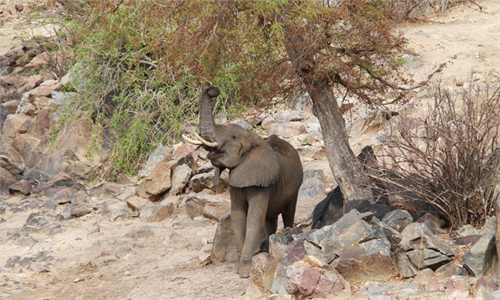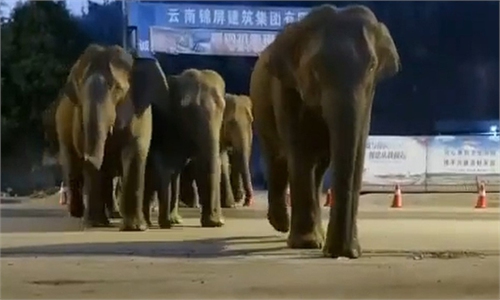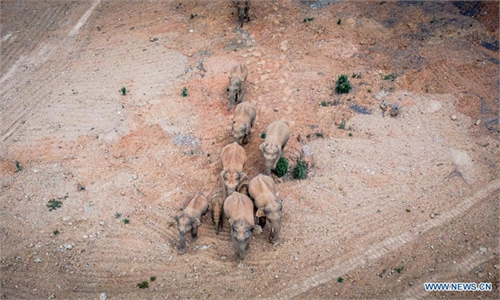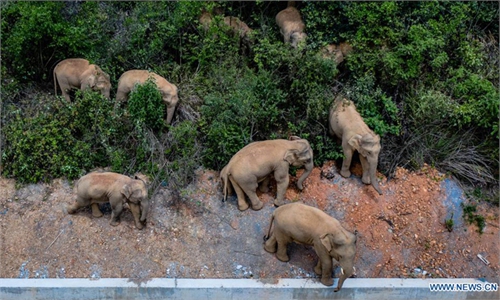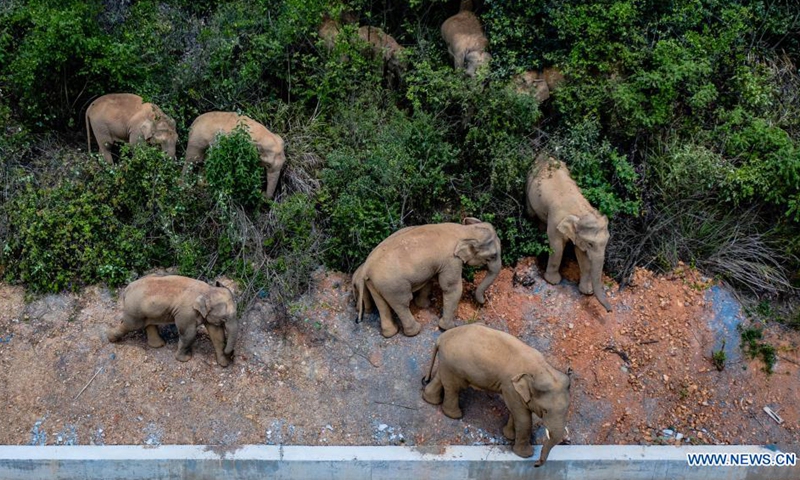
Aerial photo taken on May 28, 2021 shows a herd of wild Asian elephants in Eshan County, Yuxi City, southwest China's Yunnan Province. Authorities are tracking 15 wild Asian elephants in southwest China's Yunnan Province as the herd migrates northward. The elephants are now wandering in the county of Eshan, following a long journey from the province's southmost prefecture starting from April 16.(Photo: Xinhua)
As a herd of 15 wild Asian elephants, including three calves, has entered Kunming, the provincial capital of Southwest China's Yunnan Province, local authorities are well-prepared to respond to the migratory herd in order to ensure the safety of both the animals and humans.
Experts said that since the herd has migrated more than 500 kilometers, it could be very difficult to return the elephants to their original habitat. Elephants generally avoid going into densely populated areas due to their fear of humans.
At 9:55 pm on Wednesday, the elephants left Yuxi, Kunming and continued heading northward, local authorities reported.
The two cities have dispatched a total of 675 emergency workers and police officers, 62 vehicles, and 12 drones. Kunming has prepared 10 tons of food for the elephants, and is currently on 24-hour monitoring. Local authorities vowed to give prompt early warnings and use emergency measures to the fullest. Extra dump trucks have been employed to block roads into villages.
The elephant herd is currently in the sparsely populated suburban district of Jinning, Kunming, which is more than 50 kilometers from the city center. The adjacent areas of Kunming will further improve their human and elephant contingency plans, said local authorities.
On Tuesday, the local emergency rescue team placed corn, pineapples and other food on the route the wild elephants were taking.
There are still large areas of forest around Kunming for Asian elephants to inhabit, but there will be much less food for them there, Zhang Li, a field wildlife biologist and professor on mammal conservation at Beijing Normal University, told the Global Times on Thursday.
It is unlikely that the elephants will enter the urban area of Kunming, which is home to 8.46 million people, said Zhang, noting that wild elephants avoid densely populated areas due to their fear of humans.
But he stressed the need for the government to take all precautions, as the herd is going along a route that takes it through increasingly populous areas.
"Currently, the priority should be prevention and control around villages and townships to prevent them from entering the villages and hurting people," Zhang said.
Zhang pointed out that the herd is now travelling faster as it has entered a more densely populated area with greater human interference, which means the animals are in a nervous state.
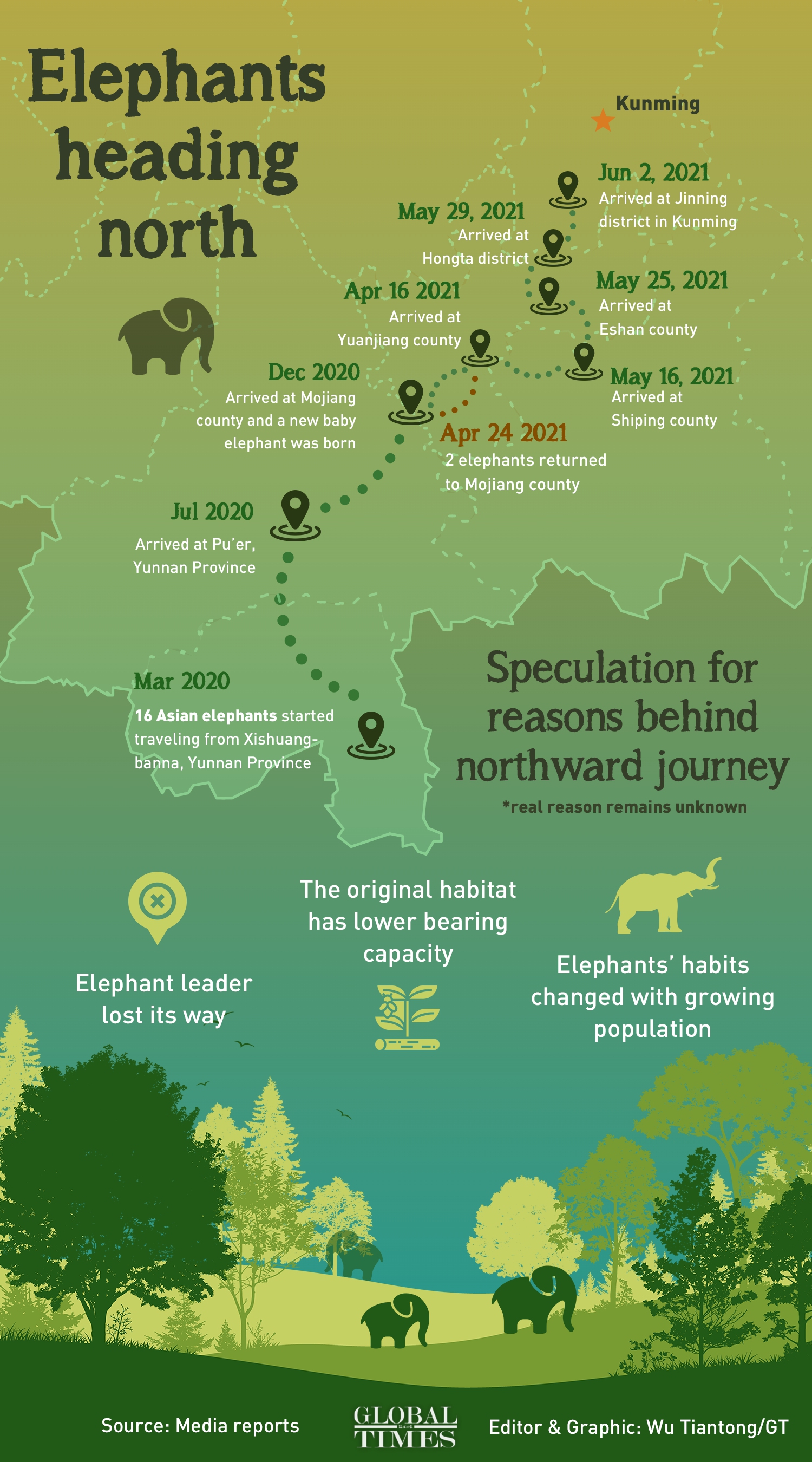
Elephants heading north Infographic: Wu Tiantong/GT
Starting from their original habitat, the Xishuangbanna National Nature Reserve in Yunnan's southernmost prefecture, on April 16, the herd has wandered over 500 kilometers northward. The herd started with 16 members, with two leaving the group and heading back, and a new one born on the journey.
It's the furthest that a herd of wild elephants in Xishuangbanna has ever travelled from its habitat. Local authorities have vowed to make every effort to persuade the animals to return home. However, since the herd has gone so far, it is unlikely that the elephants will return to their original habitat, experts said.
"The elephant herd may have left in search of food, but it is far from its original habitat, and it is less likely that it will return," Sun Quanhui, a scientist from the World Animal Protection organization, told the Global Times.
Zhang said that remote sensing satellite data analysis can be used to guide the herd to a suitable habitat. After a suitable habitat is chosen, the rescue team could use food to guide them to a nearby destination.
As for why the herd made its long journey, local officials said it may be related to the alteration in the wild elephants' diet.
Due to an increase in forest cover in the reserve, the Asian elephant's easy-to-eat plants are being constantly degraded, said Li Zhongyuan, an official from the Xisuhangbanna forestry and grassland bureau.
"The herd's eating habits have changed. The animals are now more dependent on agricultural crops like corn and sugar cane, hence they turn to agricultural land as a new habitat," Li said.
Besides, in the past two decades, Xishuangbanna has planted a large number of cash crops such as rubber and tea, and the habitat of Asian elephants has been reduced by more than 40 percent.
Meanwhile, the total number of Asian elephants in China has increased from about 170 in 1980 to 300 at present. The traditional buffer zones between humans and elephants are gradually disappearing, and the chance that elephants will encounter humans is increasing greatly.
Landscape protection planning should be carried out for Asian elephant habitats within the overall system of national parks, Zhang said. "The construction of Asian elephant ecological corridors, and the reconstruction and restoration of Asian elephant habitats, should be promoted through ecological compensation and other measures to connect fragmented habitats."
The elephant "exodus" may continue if the ecological condition of the habitat is not thoroughly improved, Zhang noted.
